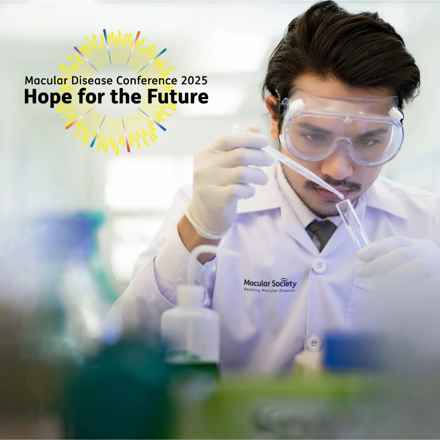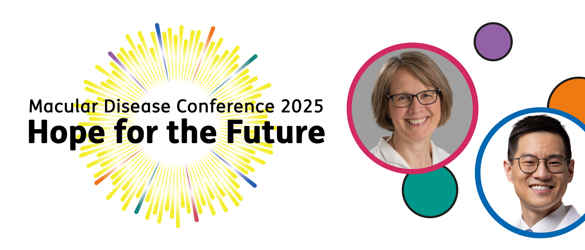Macular Society conference shines light on developing treatments
Posted: Thursday 09 October 2025
Our annual Macular Disease Conference: Hope for the Future returned in September, highlighting the experiences of people living with macular disease, exploring the latest in treatments and offering practical and emotional support.
From assistive technology, to Stargardt disease, Cone dystrophy, genetics and much more, the talks led by some of the biggest names in the macular disease research were presented to a record number of people who signed up for this year’s event.
The online conference was once again divided into three sessions: Inherited retinal diseases, age-related macular degeneration (AMD), and My Macular and Me. If you weren’t able to join on the day, each individual talk from across the sessions is now available to watch online.
New treatments for wet AMD
New treatments for AMD are evolving all the time, and for wet AMD in particular Luke Nicholson of Moorfields Eye Hospital addressed the growing number of biosimilars expected to come to market. Biosimilars are cheaper alternatives of treatments as the patents for previously licenced drugs come to an end.
He went further, discussing ongoing trials around new treatments for wet AMD and acknowledged that gene therapy is “generating a lot of excitement”.
He said: “They’re still in development, still in early stages but they represent a paradigm shift moving from frequent treatment to long-lasting potential one-time solutions. So for patients this could mean fewer appointments, fewer injections, fewer disruptions to your daily life and greater independence.”
What about dry AMD?
Researchers have been looking into what would be a breakthrough treatment as there is currently no licenced drug for those diagnosed with dry AMD in the UK. Patients are often advised to monitor their condition and consider a healthy diet rich in lutein and zeaxanthin, or take a supplement that follows the AREDS2 formula.
However, Luke highlighted trials which have looked at oral treatments (tablet), a new injection into the eye, and another into the skin.
“These treatments aren’t yet available but the reflect a diverse and promising pipeline from eye injections to tablets and skin injections. Each one brings us to a more personalised, less invasive, effective care for AMD,” he said.
Other options being explored are cell replacement therapy and retinal implants. Cell replacement looks to transplant healthy cells into a damaged area to “rebuild the retina and restore function,” said Luke.
“A growing landscape of treatment that offers real hope”
He added: “The management of advanced AMD is evolving rapidly. We’ve come a long way from limited options to a growing landscape of treatment that offers real hope. So for wet AMD, the focus is now longer acting, one-time treatment to reduce the burden and these innovations are helping us to personalise care.
“For geographic atrophy (GA) we’re finally seeing emerging treatment where we had none before, from inhibition of compliments to gene therapy and beyond. While they don’t reverse damage, they offer the chance to slow progression…and beyond medication, lifestyle advice is key.
Stargardt disease - are we close to a treatment?
Inherited retinal disease specialist Kenneh Fan, from Retina Consultants of Texas, looked at the challenges around Stargardt clinical trials. But he said there was excitement around those which are ongoing.
“Research in inherited retinal diseases has advanced a lot over the last decade, yet there is still much more to be done,” he said. Addressing Stargardt disease Kenneth said researchers were “on the cusp” of a potential breakthrough in the US.
He added: “We know there is a significant burden from Stargardt disease on the community; on family and patients so we are motivated to make a difference.”
Charles Bonnet Syndrome – hallucinations caused by sight loss
Dr Rachel Hanson presented her research into the relationship between vision and the brain, which touched on Charles Bonnet Syndrome (CBS) – visual hallucinations caused by sight loss.
Exploring this further, Dr Jasleen Jolly, associate professor of vision and eye research, debunked myths associated with the condition, as well as providing an update on CBS research and answering some of the most commonly asked questions.
Professor Jolly said the most important thing for patients was being aware of CBS and understanding the condition.
She said: “The key thing is knowledge because with knowing what it is you can take control of the hallucinations, rather than them controlling you. So, you can be reassured you’re not going crazy, this is perfectly predictable, we know this is happening, it’s acceptable so don’t worry about it.
“If they are hallucinations that you enjoy, please enjoy them – there is nothing wrong with that. If they are unpleasant hallucinations, that is when we need to start thinking about how to manage them.”
For CBS, management techniques such as blinking and moving your eyes side to side are recommended when hallucinations appear, while a short study has also looked into trans corneal electrical stimulation.
This involved Parkinson's’ hallucinations, similar to CBS, where a current was applied directly to the visual area, shown to have some effect.
“That needs a lot more evidence as it is early days in the trial,” said Professor Jolly, adding it’s “a last resort for the really troublesome and distressing hallucinations rather than as a first-line therapy.”
How to watch the Macular Disease Conference: Hope for the Future 2025
The topics didn’t stop there, with myopic macular degeneration (MMD), also put under the spotlight, as well as the emotional challenges of living with macular disease.
Each session can be watched individually, or watch the entire Conference, the complete packed programme of talks online in your own time.
Macular Disease Conference 2025 highlights
Thank you so much for joining us at the 2024 Macular Disease Conference. We’ve put together some highlights from the day for you. Watch the highlights now.
Macular Society Helpline
Free information and support to those with macular disease, along with their family and friends, to help people retain their independence.




